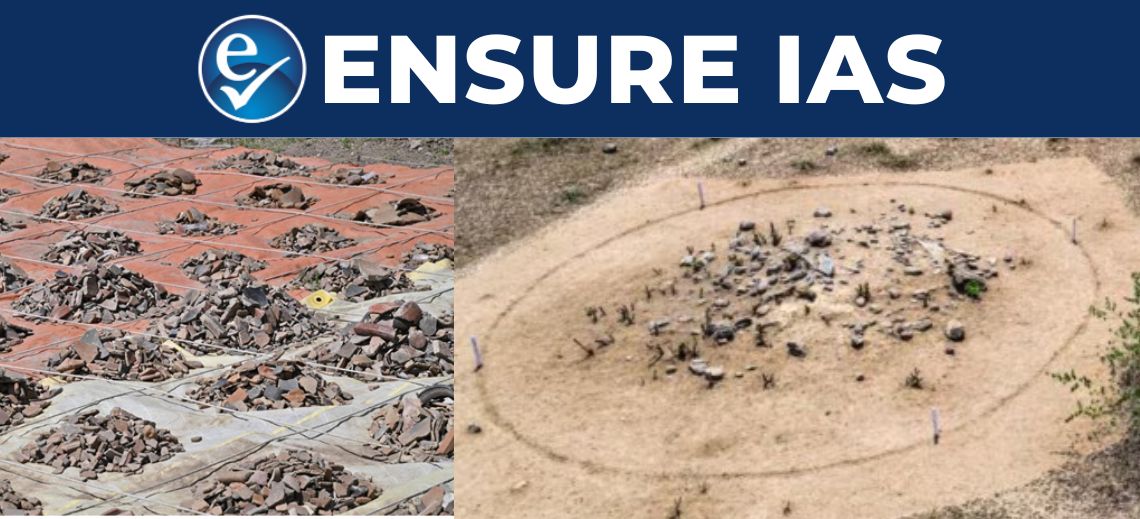- Courses
- GS Full Course 1 Year
- GS Full Course 2 Year
- GS Full Course 3 Year
- GS Full Course Till Selection
- Online Program
- GS Recorded Course
- NCERT (Recorded 500+ Hours)
- Polity Recorded Course
- Geography Recorded Course
- Economy Recorded Course
- AMAC Recorded Course
- Modern India, Post Independence & World History
- Environment Recoded Course
- Governance Recoded Course
- Science & Tech. Recoded Course
- International Relations and Internal Security Recorded Course
- Disaster Management Module Course
- Ethics Recoded Course
- Essay Recoded Course
- Current Affairs Recoded Course
- CSAT
- 5 LAYERED ARJUNA Mentorship
- Public Administration Optional
- ABOUT US
- OUR TOPPERS
- TEST SERIES
- FREE STUDY MATERIAL
- VIDEOS
- CONTACT US
New Study Reveals Iron Age began hundreds of years earlier in Tamil Nadu
New Study Reveals Iron Age began hundreds of years earlier in Tamil Nadu
25-02-2025

- In 2025, Tamil Nadu Chief Minister recently released a report ‘Antiquity of Iron: Recent Radiometric Dates from Tamil Nadu’.
- It is claimed that the Iron Age began in Tamil Nadu, dating back to the 4th millennium BCE (around 5,300 years ago).
- This challenges earlier assumptions and emphasizes the importance of Tamil Nadu in the history of the Indian subcontinent.
What Had Research Said Till Now?
1. Historical Background:
-
- The use of iron is a major technological advancement in human history.
- Earlier research suggested that iron technology came to India through immigrants from the West.
- Experts in the mid-20th century placed the origin of iron use in India at 700-600 BCE.
- However, radiocarbon dating studies later pushed the start of iron use in India to the 16th century BCE.
2. Research in Uttar Pradesh:
-
- Excavations in Uttar Pradesh in the late 1990s revealed iron smelting by the 13th century BCE.
- Sites like Raja Nala-ka-tila, Malhar, and Dadupur showed iron tools, furnaces, and tuyeres (tools for iron working) dated between 1800 BCE and 1000 BCE.
- This suggested that iron smelting was widespread in the eastern Vindhyas and the Central Ganga Plain by the early 13th century BCE.
What About Tamil Nadu?
1. Earlier Discoveries:
-
- In 2022, Mayiladumparai in Krishnagiri district was highlighted.
- The Chief Minister suggested the Iron Age in Tamil Nadu began around 4,200 years ago (third millennium BCE).
- The report ‘Mayiladumparai - Beginning of Agrarian Society; 4,200-year-old Iron Age Culture in Tamil Nadu’ linked the start of the Iron Age in Tamil Nadu to the same period as the Copper or Bronze Age in other parts of India.
2. Recent Findings:
- The new report, ‘Antiquity of Iron: Recent Radiometric Dates from Tamil Nadu’, supports this timeline.
- It suggests that while northern India was in the Copper Age, southern regions like Tamil Nadu had already entered the Iron Age due to the limited availability of copper ore in the region.
- Excavations at sites like Sivagalai, Adichanallur, Kilnamandi, and Mayiladumparai show that the Iron Age in Tamil Nadu started between 3,345 BCE and 2,953 BCE.
3. Conclusion of Report:
-
- Scholars now conclude that the Iron Age in Tamil Nadu began in the first quarter of the 4th millennium BCE.
- While these findings are important, scholars note that this does not mean the Iron Age started in Tamil Nadu but coexisted with developments in other regions.
Iron Age & Copper-Bronze Age Likely Contemporary in India:
- The study suggests that, unlike the global progression where the Iron Age followed the Copper-Bronze Age, these two periods may have coexisted in India.
- Previously, the Iron Age in India was believed to begin between 1500 BCE to 2000 BCE, shortly after the Indus Valley Civilization.
- This new research challenges theories proposed by scholars like V. Gordon Childe and Mortimer Wheeler, who suggested iron technology spread from a single Western center to India.
Dating Techniques Used in Study:
- Radiometric Dating is a scientific method used to determine the age of materials like rocks, fossils, or artifacts by analyzing the decay of radioactive isotopes.
- Accelerator Mass Spectrometry (AMS) is a high-precision radiometric dating technique used to measure radioisotope ratios for accurate age determination.
- Optically Stimulated Luminescence (OSL) Analysis is a technique that dates the last time minerals like quartz or feldspar were exposed to light or heat.
Conclusion:
The study provides new insights into the early use of iron in India, pushing back the timeline of the Iron Age and challenging established global and regional theories. By using advanced dating techniques, it reveals that iron technology was in use in Tamil Nadu long before the traditionally accepted Iron Age timelines.
|
Also Read |
|
| FREE NIOS Books | |




